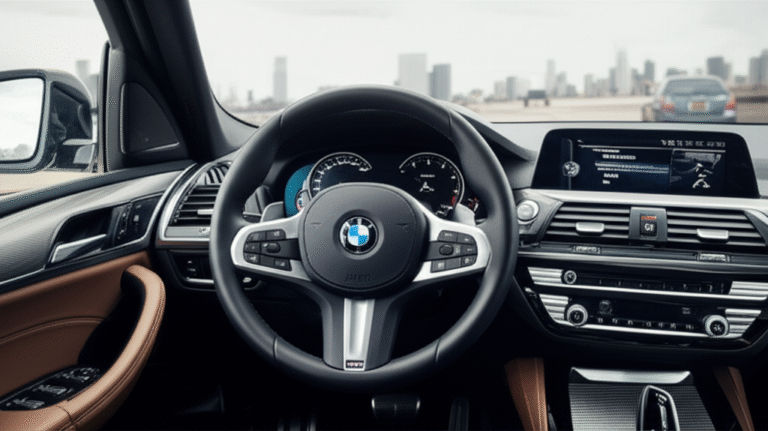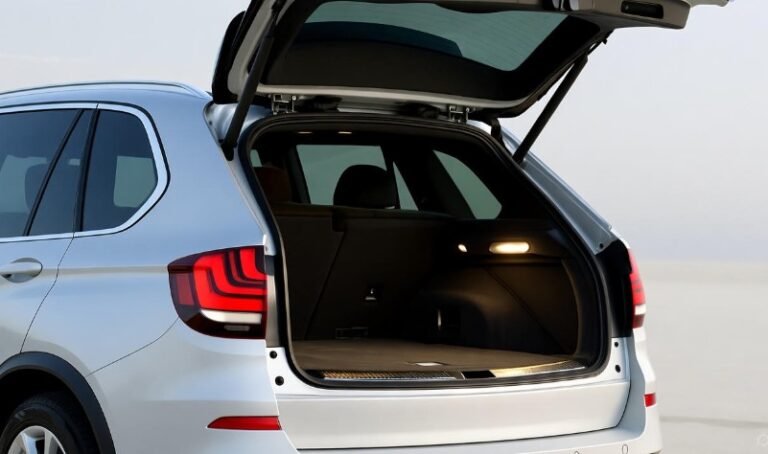BMW 5 Series Tyre Size: 5 Crucial Specs
BMW 5 Series Tyre Size: 5 Critical Specs Every Buyer Must Know
Key Takeaways
Confirm your BMW 5 Series tyre size on the sidewall.
Understand tyre aspect ratio for handling and comfort.
Check load index for safe weight-carrying capacity.
Note speed rating for optimal performance.
Consider rim diameter for proper fitment.
When it comes to your BMW 5 Series, every detail matters. This includes ensuring you have the correct tyre size. Incorrect tyres can affect your car’s performance, safety, and even its fuel efficiency. It might seem like a small detail, but knowing your BMW 5 Series tyre size is crucial for maintaining that signature BMW driving experience. This guide will break down the five essential specifications you need to know, making it simple and stress-free. Let’s make sure your luxury sedan is always riding on the right paws.
Why BMW 5 Series Tyre Size Matters So Much
Your BMW 5 Series is engineered for precision, performance, and comfort. The tyres are a fundamental part of this engineering. They are the single point of contact between your vehicle and the road, influencing everything from acceleration and braking to steering response and ride quality. Choosing the wrong tyre size can lead to a multitude of problems. It can throw off your car’s speedometer, affect the Anti-lock Braking System (ABS) and Electronic Stability Control (ESC) calibrations, and even cause uneven wear on your tyres and suspension components. For a vehicle like the BMW 5 Series, which offers a dynamic driving experience, maintaining the correct tyre specifications is not just about comfort; it’s about preserving the integrity of the car’s sophisticated systems. Understanding these specs ensures you maintain safety, performance, and the intended driving dynamics that BMW is renowned for.
Decoding Your BMW 5 Series Tyre Size: The 5 Crucial Specs
The tyre sidewall is a treasure trove of information, but it can look like a foreign language at first glance. For your BMW 5 Series, these five specifications are the most important for selecting the correct replacement tyres:
1. Tyre Width (Section Width)
The first number in a tyre size designation, like ‘245’ in 245/40R18, represents the tyre’s section width in millimeters. This is the measurement of the tyre from one sidewall to the other at its widest point, excluding any protective ribs or markings. A wider tyre generally offers better grip and stability, especially during cornering, which is a hallmark of the BMW driving experience. However, excessively wide tyres can increase rolling resistance, potentially reducing fuel economy and making the steering feel heavier. Conversely, narrower tyres might offer better fuel efficiency and performance in snow but can compromise dry grip and cornering ability. The engineers at BMW carefully select the optimal width for each 5 Series model to balance these factors.
2. Aspect Ratio (Tyre Profile)
Following the width is the aspect ratio, expressed as a percentage. In our example of 245/40R18, the ’40’ signifies that the tyre’s sidewall height is 40% of its width. So, for a 245mm wide tyre, the sidewall height is 245mm 0.40 = 98mm. This ratio is often referred to as the tyre’s profile. A lower aspect ratio (e.g., 35, 30) means a shorter sidewall, commonly found on performance-oriented vehicles. Shorter sidewalls provide a firmer ride and more direct steering response because there’s less flex between the rim and the road. A higher aspect ratio (e.g., 50, 55) results in a taller sidewall, which generally offers a more comfortable ride by absorbing more road imperfections and can be more resilient against pothole damage. For the BMW 5 Series, you’ll typically find lower aspect ratios, contributing to its sporty handling.
3. Tyre Construction Type
The letter(s) following the aspect ratio indicate the tyre’s construction. For most modern BMW 5 Series vehicles, you will see an ‘R’, which stands for Radial construction. This means the tyre’s internal plies are arranged radially, running perpendicular to the direction of travel. Radial tyres are standard in the automotive industry today due to their superior performance, durability, and fuel efficiency compared to older bias-ply designs. They offer better flexibility, heat dissipation, and a larger contact patch with the road, all contributing to improved handling and a smoother ride. While other construction types exist (like ‘B’ for Bias-ply), they are not common for the BMW 5 Series. Always ensure you are selecting ‘R’ for radial tyres for your 5 Series.
4. Rim Diameter (Wheel Size)
The number after the construction type, such as ’18’ in 245/40R18, indicates the diameter of the wheel (rim) that the tyre is designed to fit, measured in inches. This is a critical dimension; a tyre with a 17-inch rim diameter will not fit on a wheel designed for an 18-inch rim, and vice-versa. BMW 5 Series models come with a variety of wheel sizes from the factory, often ranging from 17 inches up to 20 inches or more, depending on the specific trim and optional packages. When replacing tyres, you must match this rim diameter precisely. For example, if your 5 Series has 19-inch wheels, you need tyres specified for an 19-inch rim. The size of the rim diameter significantly impacts the overall tyre diameter and the aspect ratio choices available.
5. Load Index
The load index is a numerical code that indicates the maximum weight each tyre can support when inflated to its specified pressure. This is usually the last number in the tyre size code (e.g., a tyre might be 245/40R18 97Y). The number ’97’ here is the load index. You’ll need to refer to a tyre load index chart to determine the exact weight capacity. For instance, a load index of 97 typically corresponds to a maximum load of 730 kilograms (or about 1609 pounds) per tyre. It is crucial that the load index of your new tyres meets or exceeds the original equipment (OE) specification for your BMW 5 Series. Under-specifying the load index can lead to tyre failure, compromised handling, and a dangerous driving situation. You can usually find the OE load index in your owner’s manual or on a sticker located in the driver’s side doorjamb.
6. Speed Rating
Often paired with the load index, the speed rating is a letter code (e.g., ‘Y’ in 245/40R18 97Y) that indicates the maximum speed at which the tyre can safely carry its rated load. Each letter corresponds to a specific maximum speed in miles per hour. For example, ‘Y’ is a high-speed rating, often indicating a maximum speed of 186 mph. Other common ratings include ‘H’ (130 mph), ‘V’ (149 mph), and ‘W’ (168 mph). Similar to the load index, your replacement tyres must have a speed rating that meets or exceeds the original specification for your BMW 5 Series. Using tyres with a lower speed rating than the vehicle is designed for can compromise safety, especially at higher speeds, and can lead to tyre overheating and potential failure. Always consult your owner’s manual for the correct speed rating for your model.
Where to Find Your BMW 5 Series Tyre Size
Finding the correct tyre size for your BMW 5 Series is straightforward once you know where to look. Here are the most common places:
- Driver’s Side Doorjamb Sticker: This is usually the most reliable place. Open the driver’s door, and look on the frame of the car body. You’ll find a sticker that lists the recommended tyre sizes, inflation pressures, and often the load index and speed rating.
- Owner’s Manual: Your BMW 5 Series owner’s manual will have a dedicated section on wheels and tyres, detailing all the original specifications for your vehicle.
- Fuel Filler Door: Some manufacturers place a similar sticker inside the fuel filler door.
- Tyre Sidewall: As discussed, the tyre itself carries all the size information. However, if your current tyres are not the correct size, you’ll need to find the OE information from one of the other sources.
If you are unsure, consulting a BMW dealership or a reputable tyre professional can provide the definitive answer for your specific vehicle. For a comprehensive guide on tyre basics, the National Highway Traffic Safety Administration (NHTSA) offers excellent resources.
Comparing Common BMW 5 Series Tyre Sizes
BMW offers its 5 Series in various configurations, and the tyre sizes can differ significantly between models and trim levels. Here’s a look at some common tyre sizes you might encounter on different generations and trims of the BMW 5 Series:
Typical Tyre Sizes by 5 Series Generation
| BMW 5 Series Generation | Common Tyre Width (mm) | Common Aspect Ratio (%) | Common Rim Diameter (inches) | Example OE Size |
|---|---|---|---|---|
| F10 (2010-2017) | 225 – 275 | 35 – 50 | 17 – 19 | 245/45R18 96Y |
| G30 (2017-Present) | 245 – 275 | 30 – 40 | 18 – 20 | 245/40R19 98Y XL |
| E60 (2003-2010) | 225 – 245 | 40 – 55 | 16 – 18 | 225/50R17 94V |
| E39 (1995-2003) | 205 – 235 | 50 – 60 | 15 – 17 | 225/55R16 95W |
Note: These are common examples. Specific models (e.g., M Sport packages, different engine variants) can have different OE tyre sizes. Always verify your vehicle’s specific requirements.
It’s also not uncommon for BMW 5 Series vehicles to come with staggered wheel setups, where the front and rear tyres are different sizes. This is particularly true for performance-oriented models or those with larger wheels. For example, you might find wider tyres on the rear axle to enhance traction and improve power delivery. Always check the documentation for both front and rear tyre specifications if your vehicle has a staggered setup.
Understanding Tyre Markings: More Than Just Size
Beyond the primary size designation, other markings on your tyre sidewall provide valuable information for your BMW 5 Series:
- DOT (Department of Transportation): This signifies that the tyre meets all federal safety standards. The characters following DOT indicate the manufacturer, plant code, tyre size code, and the date of manufacture (often the last four digits represent the week and year, e.g., ‘3022’ for the 30th week of 2022).
- UTQG (Uniform Tyre Quality Grading): This system, primarily used in the US, grades tyres on Treadwear, Traction, and Temperature resistance.
- Treadwear: A comparative rating based on the tyre’s expected lifespan relative to a baseline tyre (e.g., 400, 500). Higher numbers suggest longer tread life.
- Traction: Graded as AA, A, B, or C, indicating the tyre’s ability to stop on wet pavement. AA is the highest.
- Temperature: Graded as A, B, or C, indicating the tyre’s resistance to heat build-up at speed. A is the highest.
- M+S (Mud and Snow): Indicates the tyre is designed to provide better performance in mud and snow conditions. Many all-season tyres carry this marking.
- Three-Peak Mountain Snowflake (3PMSF): A more rigorous standard than M+S, indicating the tyre has passed specific performance tests in severe snow conditions. This marking is crucial for winter tyres or all-weather tyres intended for demanding winter climates.
- Tire Pressure Monitoring System (TPMS) Symbol: If your BMW 5 Series is equipped with TPMS, you might see a specific symbol indicating compatibility.
Understanding these markings helps you choose tyres that not only fit but also perform optimally and safely in your driving conditions.
The Impact of Tyre Condition on Your BMW 5 Series
Even the correct tyre size won’t matter if the tyres are worn out or improperly maintained. The condition of your tyres directly impacts your 5 Series’s safety and performance.
Tyre Tread Depth
Tread depth is critical for grip, especially in wet conditions. As the tread wears down, the tyre’s ability to channel water away from the contact patch diminishes, increasing the risk of hydroplaning. The legal minimum tread depth in the USA is 2/32 of an inch. However, for optimal safety and performance on your BMW 5 Series, especially in adverse weather, it’s recommended to replace tyres when the tread reaches 4/32 of an inch. You can check tread depth using a simple tread depth gauge or by looking for the “tread wear indicators” – small raised bars in the grooves that are flush with the tread surface when it’s worn down.
Tyre Inflation Pressure
Maintaining the correct tyre pressure is vital. Under-inflated tyres can overheat, leading to premature wear and an increased risk of blowouts. They also reduce fuel efficiency and negatively affect handling. Over-inflated tyres can lead to a harsh ride, reduced grip, and uneven wear. The recommended tyre pressure for your BMW 5 Series is not the maximum pressure listed on the tyre’s sidewall, but the specific pressure recommended by BMW, usually found on the driver’s side doorjamb sticker or in the owner’s manual. This pressure is often different for the front and rear tyres and can vary based on load.
Tyre Age
Tyres degrade over time, even if they have plenty of tread left. The rubber compounds can become brittle, reducing grip and increasing the risk of failure. Most manufacturers recommend replacing tyres that are six years old or older, regardless of tread wear. The tyre’s manufacturing date is indicated by the last four digits of the DOT code (e.g., ‘3022’ means the 30th week of 2022). If the date is unclear or you’re unsure of the age, it’s best to consult a professional.
For more on tyre maintenance, the Tire Industry Association provides comprehensive information.
Pro Tips
Pro Tip: When replacing tyres on your BMW 5 Series, it’s highly recommended to replace them in full sets (all four tyres) to ensure consistent handling and braking performance. If you must replace only two, always install the new tyres on the rear axle, regardless of whether the old ones were on the front or rear, to help maintain vehicle stability.
Frequently Asked Questions About BMW 5 Series Tyre Size
What is the most common tyre size for a BMW 5 Series?
While there isn’t one single “most common” size due to variations across model years and trims, for newer generations like the G30, sizes such as 245/40R19 and 245/45R18 are frequently seen as original equipment. Always confirm with your vehicle’s specific sticker or manual.
Can I put a different size tyre on my BMW 5 Series?
It’s generally not recommended to deviate significantly from the original equipment (OE) tyre size specified by BMW. While some minor variations in diameter or width might be permissible (within a small percentage, often 1-3%), significant changes can affect speedometer accuracy, electronic systems (ABS, ESC), suspension geometry, and vehicle handling. For best results and safety, stick to the OE size or consult a specialist for approved alternatives.
What does the ‘XL’ mean on a BMW 5 Series tyre?
The ‘XL’ stands for Extra Load. Tyres marked ‘XL’ have a higher load-carrying capacity than standard load tyres of the same size. If your BMW 5 Series OE tyre has an ‘XL’ or ‘RF’ (Run-Flat) marking, your replacement tyres should also have this designation to maintain the vehicle’s load capacity and performance characteristics.
Are run-flat tyres necessary for my BMW 5 Series?
Many BMW 5 Series models come equipped with run-flat tyres (RFTs) as standard. These tyres allow you to drive for a limited distance at reduced speed even after a complete loss of air pressure. While convenient, RFTs can offer a firmer ride and are often more expensive. If your car came with RFTs, you can replace them with other RFTs or switch to conventional tyres, but you should also consider adding a spare tyre or a tyre repair kit if you opt for conventional tyres, and your vehicle may not have a spare tyre bay.
How often should I check my BMW 5 Series’ tyre pressure?
It’s recommended to check your tyre pressure at least once a month, and before any long journeys. Fluctuations in temperature can also affect tyre pressure, so checking more frequently during seasonal changes is a good practice.
What if my BMW 5 Series has staggered wheels?
If your 5 Series has staggered wheels, the front and rear tyres will have different sizes (typically wider on the rear). You must ensure you purchase the correct size for each axle, as specified by BMW. Mismatched sizes on different axles can severely compromise your car’s handling and safety systems.
Conclusion
Navigating the world of BMW 5 Series tyre sizes doesn’t have to be a daunting task. By understanding the five crucial specifications—tyre width, aspect ratio, construction type, rim diameter, load index, and speed rating—you empower yourself to make informed decisions. This knowledge ensures that your luxurious 5 Series continues to provide the exceptional performance, safety, and comfort it was engineered for. Always refer to your vehicle’s specific recommendations, found on the doorjamb, fuel filler door, or in your owner’s manual, to guarantee you’re selecting the perfect fit. Proper tyre selection and maintenance are cornerstones of a confident and enjoyable driving experience, keeping you securely connected to the road ahead.




